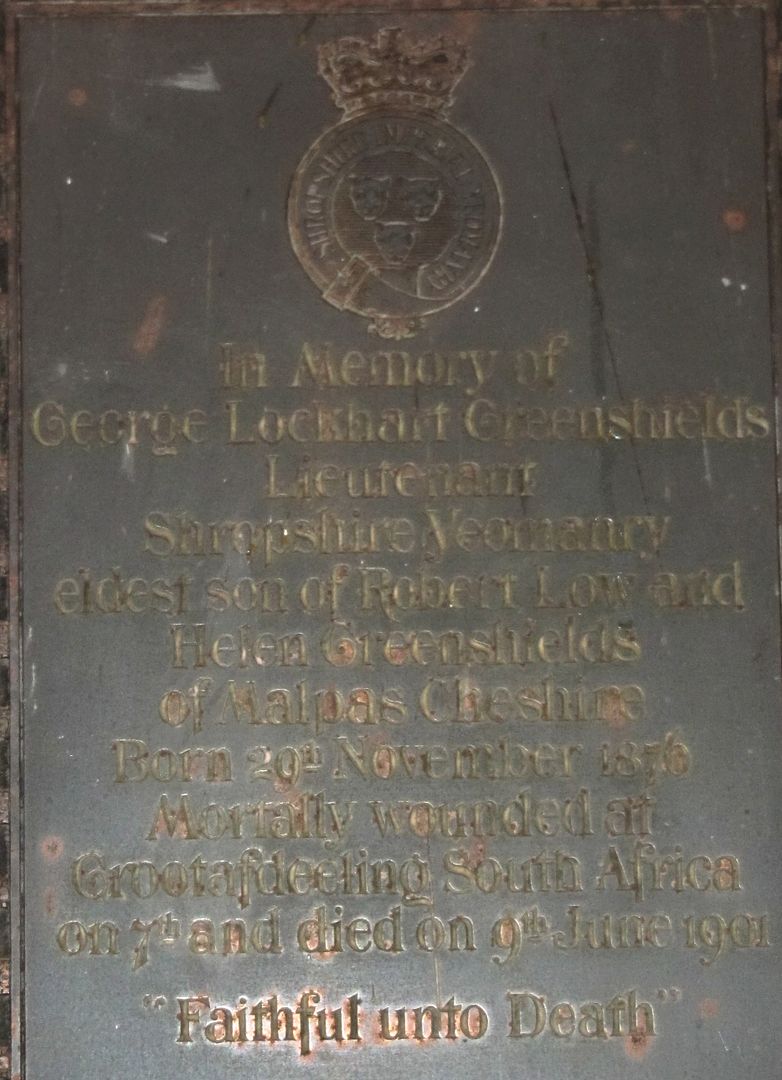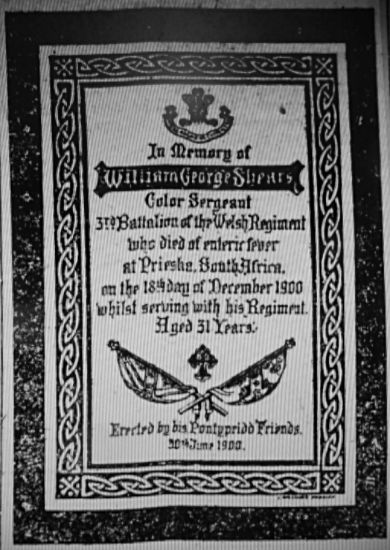This is the first time I've come across a photograph of a memorial reproduced in a contemporary newspaper.
_____________________________________________________________
News reached Pontypridd on Thursday evening that Sergeant Shears, of the Welsh Regiment, had succumbed to enteric fever. The deceased resided in the town for some years as a recruiting officer. He had not been married very long before his departure for the front. His widow is the eldest daughter of Mrs. Thomas, Sportsman Hotel, Pontypridd.
(The Western Mail, Friday 21st December 1900)
_____________________________________________________________
Due to the condition of the newpaper, it's not been possible for me to be able to transcribe the article fully.
newspapers.library.wales/view/3814051/3814054/6/
IN MEMORIAM.
COLOUR-SERGEANT W. G. SHEARS.
............ THE MYSTERY.
St. Catherine's Church, Pontypridd, was
the scene of an impressive military ceremony
[on Sunday], the occasion being the unveiling of a brass tablet to the memory of Colour-Sergeant Shears, 3rd Battalion Welsh Regiment, who succumbed to enteric fever at Prieska, South Africa, on the 18th December, 1900.
The deceased Sergeant was quite a young man, being only 31 years of age. Born on the 15th February, 1870, he had spent most of his time in the army and was a familiar figure in Pontypridd, where for nearly five years he acted as recruiting sergeant. On the ..th February, 1899, he married to the only daughter of Mrs Parry Thomas, of The Sportsman Hotel. On the outbreak of the war, it was not long before his services were required with the Colours, and he was detailed for active service in November the same year. Proceeding to the seat of war, he was quartered for a month at De Aar, and afterwards at Prieska.
There he was placed in the responsible position of District Superintendent of Military Defence, and gained for himself not only the highest confidence of his officers, but the respect of both soldiers and civilians who came within the sphere of his genial influence.
His death, as is usual in cases of enteric, was awful in its suddenness, and the regard in which he was held was made manifest at the funeral, when both Briton and Boer alike assembled to pay the last tribute of respect to his memory.
The remains were laid to rest in the Cemetery attached to the Dutch Reform Church, the Rev. Van Wyck conducting the service in the presence of the whole of the garrison who cold be spared from duty, and a large number of the townspeople.
As practical proof of sympathy, the members of his Corps have raised a subscription to raise a monument over his grave, which, as it would have to be brought by road some hundreds of miles from Kimberley or Cape Town, cannot at present be erected, the highways, such as they are, not being safe for transport. It will, however, be done as soon as the country becomes pacified.
The tablet in St. Catherine's Church is to be a standing testimony for all time, so long as the building shall last, of the regard in which the late Sergeant was held by his Pontypridd friends.
A committee had been formed to consider the best means of showing their respect, Mr David Jenkins, Hopkinstown, acting as chairman, and Mr Morgan John and Mr J. D. Phillips as secretary and treasurer respectively, with a large number of those ....ested, the tablet being the outcome of their deliberations. The church, on Sunday, presented quite a military appearance. Amongst the Regulars of the 3rd Welsh Regiment were Sergeant Major Hassell, Q.M. Sergeant Acraman, C. Sergeants Wallace and Jones, Sergeants Lesser, Russel, Campbell, Pettard, Payne, Mr Miles and Mr ..mphlin, all of whom came up specially from Cardiff. The Pontypridd Detachment of Volunteers, 3rd Welsh regiment, turned out a good muster, Captain J. S. ...es, Captain R. A. Lewis, Lieut. J. G. ..... (Ap Caradog). and Lieut. Rhys Griffith
being the officers in command. Drill Instructor Sergeant Perkins, Pontypridd, and Sergeant Murphy were also present. Bandmaster Norton played suitable selections of music to and from the church, and at the end of the service rendered with fine effect Rossini's "Quondam Corpus," from the Stabat Mater. In addition to the Pontypridd Volunteers, about thirty men from the Taff's Well Corps, with Sergeant Instructor Leary, under the command of Capt. Lewis, Greenmeadow, and the Pontypridd Fire Brigade, under Capt. Brooks, Lieuts. Bromage and Brown, and Foreman Mitchell, attended. After the singing of the last hymn before the sermon, Mr Gordon Lenox unveiled the tablet, which is of brass, and read the inscription aloud as follows: -
"In memory of Wm. G. Shears, Colour Sergeant, 3rd Battalion of the Welsh Regiment, who died of enteric fever at Prieska, South Africa, on the 18th day of December, 1900, whilst serving with his regiment, aged 31 years. Erected by his Pontypridd friends, 30th June, 1901."
As Mr Lenox spoke there was a deep silence, almost painful in its solemnity, which was maintained as the funeral service was gone through. It is at such time the sacredness of life is felt, there being few who have not in their hearts, deep hidden away, a sorrow of some kind, the loss of a parent, son, wife, brother, sister or friend, the sting of whose departure remains dormant until the emotions stirred by sympathy with others, re-opens a wound which had been thought to have long since healed. Such moments as these have humanising and holy influence, when, in the House of God, men and women bow the knee in reverence to their Creator as they mingle tears of sympathy one with another in a common ....
The Rev. J. P. Griffiths, vicar (by whose permission the tablet was erected), preached, taking his text from VI. Chapter of St. Paul's Sermon on the Mount, "Give, and it shall be given unto you," and in eloquent and convincing terms pointed his references to the attentive congregation.
(The Pontypridd Chronicle and Workman's News, Saturday 6th July 1901)
_____________________________________________________________
A PONTYPRIDD MEMORIAL.
Below we produce a photo of the tablet just erected in St. Catherine's Church, Pontypridd, in memory of Colour-sergeant Shears, who died from enteric fever at Prieska, South Africa.
It was unveiled by Mr. Gordon-Lennox, J.P., and bears the badge and motto, and also the flags of the Welsh Regiment, inlaid in their proper colours. The border stands in relief, is of Celtic design, and is mounted on a black polished slab. The work was entrusted to Mr. John Williams, Castle Arcade, Cardiff.
(Evening Express, Wednesday 17th July 1901)
Note the spelling of
Color in the inscription.





























